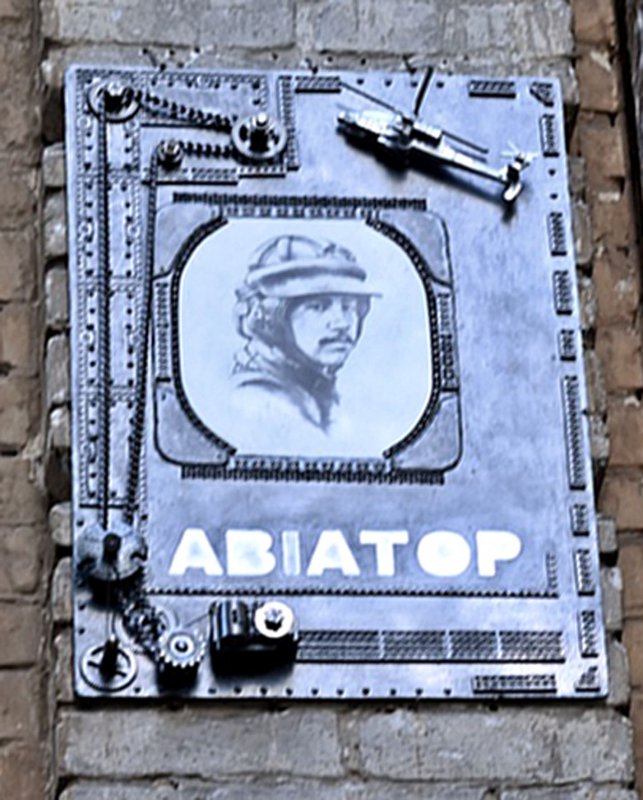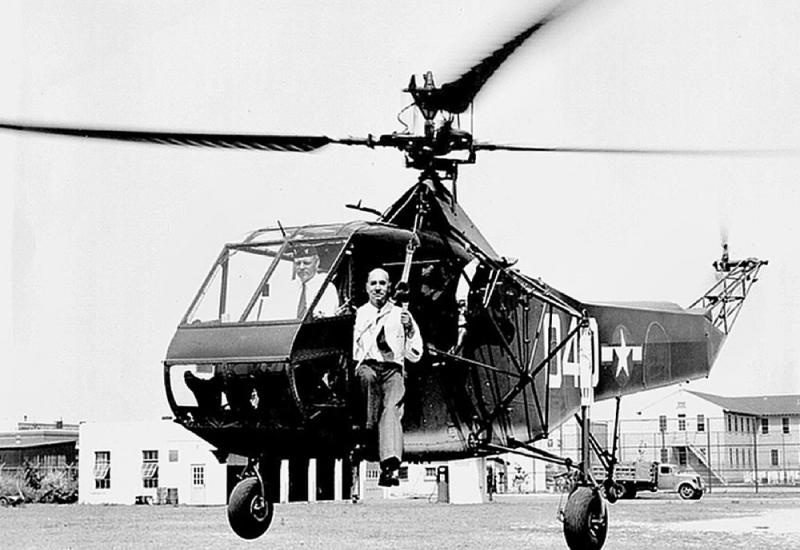50 years ago, on October 26, 1972, Igor Ivanovych Sikorsky, a legendary aircraft designer from Kyiv who became a pioneer of domestic aviation at the beginning of the 20th century, passed away in the USA.
It was in Kyiv that his brilliant career as an aircraft designer began, and his father's homestead, which is still called "Sikorsky's house", and the Kyiv Polytechnic Institute served as a launchpad. Igor Sikorsky was not the inventor of the airplane or the helicopter, but he became the creator of extremely successful airplanes, and then the best rotorcraft of his time. Tragic revolutionary events forced him to emigrate to the USA, where he founded the company "Sikorsky Aircraft" (he was called Mr. Helicopter), participated in the cultural life of the emigrant community, published several religious and philosophical works and left a good memory among his compatriots .
For Kyiv Polytechnic Institute, Igor Sikorsky is a special person, and it is not for nothing that his name is immortalized even in the name of the university and in the name of one of the most famous Ukrainian festivals of innovators, which is held annually here. So this material is not only a homage and a tribute to the memory of the brilliant compatriot, but also a reminder of his outstanding achievements and difficult life.

ON THE WAY TO THE SKY
Humanity has dreamed of a way to the sky since ancient times. The oldest legends tell about people who attempted to fly by tying wings similar to those of birds (remember the Greek legend of Daedalus and Icarus). However, only at the end of the 18th century did practical exploration of skies began. The balloons of the Montgolfier brothers and the Parisian professor Charles flew into the sky of Europe, which were enthusiastically greeted by crowds of spectators.
At the end of the 19th century, the possibility of flying devices heavier than air was proven. In Germany, where Igor Sikorsky came with his father, Professor Ivan Oleksiyovych Sikorsky, he first learned about the flights of Count Zeppelin's airships and first got acquainted with the literature devoted to the Wright brothers. Probably, he was lucky to be at the origins of the aviation business in time, especially since the Kyiv Polytechnic Institute - his alma mater - became the center of aeronautics in Kyiv. During the years of study at the mechanical department, the young man managed to visit the Devigner deLannoit Technical School in Paris. There he finally realized that aviation is his life's work.
But at first there was a father's homestead in Kyiv in Velyka Pidvalna street (now Yaroslaviv Val St.), 15-b. The housing of those times has almost not been preserved in this area, except for a three-story outbuilding, which is usually called "Sikorsky's house". The large Sikorsky family lived there, and the legendary aircraft designer Igor Ivanovych Sikorsky, the youngest in the family (fifth child), was born there on June 6, 1889. The second and third floors of this building housed the Medical and Pedagogical Institute for Sick Children. His sisters Olga and Olena Sikorsky were the founders, and his father, Ivan Sikorsky, a well-known neurologist and psychiatrist, an outstanding scientist, the head of the department of the Kyiv University of the Saint Volodymyr, was the scientific consultant there.
As with many Ukrainian intellectuals, the ancestors of the Sikorskys belonged to the clergy. Igor Sikorsky mentioned that in a letter to Vasyl Halych written in English and dated August 30, 1933: "My family, which comes from a village in the Kyiv region, where my grandfather and great-grandfather were priests, is of purely Ukrainian origin..." This is probably the only well-known document signed by Igor Sikorsky, in which he talks about his ethnicity.
What influenced the choice of the life path of a young man, a future aircraft designer? Probably Maria Stefanivna's, his mother’s, stories about the amazing world of scientific ideas of the Renaissance genius Leonardo da Vinci, in particular, his ideas about the legendary helicopter.

FIRST STEPS TO THE DREAM
Igor Sikorsky began designing his first flying machine - a helicopter - in the summer of 1908. He carried out his research on the territory of his father's homestead. The young inventor lacked the experience and funds to purchase a powerful motor. After all, some complete parts for flying machines, in particular "Anzani" engines, had to be purchased in Paris, the world aviation center of that time. So, his father Ivan Oleksiyovych and his sister Olga became his first sponsors. Soon Igor realized that experiments with a helicopter were better to postpone for the future, and decided to start designing more promising airplanes.
The following years of Sikorsky's life were full of hard work developing a number of airplanes from C-1 to C-5. Based on the fundamental knowledge acquired at the institute, Igor developed the foundations of his own aircraft design theory, the cornerstone of which was an original methodology for calculating the parameters of the airplane, the wing lift, its dimensions, configuration, etc.
The airplanes he built in Kyiv brilliantly confirmed the accuracy of his theoretical calculations. But the main thing happened at the airfield. In December 1909, the Sikorsky C-6 airplane reached a speed of 111 kilometers per hour, thereby breaking the world record. The use of a makeshift range for checking aerodynamic parameters during the craft assembly facilitated that among other things.
Records were also set on the S-6A aircraft. During the competition at the Moscow Aeronautical Exhibition in April 1912, this aircraft received the Grand Gold Medal from the Russian Technical Society. After that, the young aviator, who was not even 23 years old, received an invitation to become the chief designer of the aviation department of the Russo-Baltic Wagon Plant ("Russo-Baltique").
It was a very honorable proposal for a student of Kyiv Polytechnic Institute. Igor Sikorsky's greatest achievements before his departure abroad were later associated with this enterprise. He implemented his revolutionary idea for the creation of multi-engine airplanes, which became the forerunners of the grand "Ilya Muromets", which was later recognized as the best aircraft of the First World War.
Igor Sikorsky organized an ultra-long flight on the route Petersburg-Kyiv-Petersburg to demonstrate the extraordinary flight qualities of this aerial monster in June 1914.
Three years later, the revolutionary events in the Russian Empire caused great chaos in the country: it was no longer interested in aviation. Moreover, Sikorsky himself was in real danger as a well-known designer who was personally awarded an order by Tsar Nicholas II. He had to emigrate. In February 1918, he went to France and offered his services to the military department there. But the war was coming to an end, the need for new military aircraft diminished, and his proposals were rejected. And he remembered a huge country across the ocean...
MR HELICOPTER
The first years of his stay in the United States of America were extremely difficult: Sikorsky had to make ends meet giving mathematics lessons.
Only in 1923 did he return to the main business of his life. He founded the aviation company "Sikorsky Aero Engineering Corporation'' together with aviation enthusiasts, and headed it. However, the start of its activity was extremely dramatic. It is known that his company was saved from collapse by the composer and pianist Sergei Rachmaninoff, who provided Sikorsky with financial support of $5,000, which was quite significant for those times. Subsequently, the aircraft designer returned this loan with interest.
Meanwhile, Sikorsky's company merged with the United Aircraft company, where he became a specialist in design development. He designed amphibious seaplanes, which were needed by the company "Pan American World Airways". In 1931, Sikorsky's first seaplane S-40 ("American Clipper") began servicing the mail-passenger routes of the airline company "Pan American Airways". Serial seaplanes S-42 set ten world records and ensured regular flights of intercontinental passenger liners.
During the years 1925-1939, Igor Sikorsky developed a series of extremely successful aircraft. However, he did not give up hope of dealing with the helicopter theme., Sikorsky conducted research with his colleagues in his spare time, and patented a number of developments. From now on, he had his own aerodynamic theory and experience, which he missed so much at the beginning of the 20th century.
In 1939, Sikorsky switched to the design of single-screw helicopters, and on September 14, his VS-300 helicopter took off. It was flown by the aircraft designer himself. By the way, throughout his career, Igor Sikorsky insisted that he should perform the first flight of the aircraft he designed. In 1941, the US Armed Forces were equipped with Sikorsky helicopters, and more than 400 of them were supplied during World War II.
Since 1943, the company "Sikorsky Aircraft" has become a leading manufacturer of rotorcraft equipment abroad. Sikorsky helicopters were used for both military and civilian use. The aircraft designer himself considered the helicopter a vehicle useful in industry and business, but primarily important for rescuing people in the event of fires, floods, and other emergencies. According to Sikorsky's calculations, his rotorcraft saved more than 50,000 lives. The high reliability and safety of Sikorsky helicopters is evidenced by the fact that they are constantly used by US presidents as VIP transport.
He was the first to build turbine helicopters, amphibious helicopters and crane helicopters. In total, the Sikorsky Aircraft company created 17 basic aircraft and 18 rotorcraft. All experimental samples designed under his leadership had their continuation in mass production. Igor Sikorsky's aircraft held many records. Thus, the S-61 helicopter was the first in the world to fly across the Atlantic in 1967, and across the Pacific Ocean with refueling in the air in 1970.
In the world, Sikorsky was called Helicopterman No. 1 (or Mr. Helicopter). During his lifetime, he received more than 80 different prizes, awards and honorary titles. In the USA, his name is inscribed in the National Inventors Hall of Fame. But he considered the ASME medal, the highest scientific award of the American Society of Mechanical Engineers, and the John Fritz Medal "For scientific and technical achievements" in the field of aviation to be the most honorable, which, in addition to Sikorsky, was also held by Orville Wright, the famous developer of the first airplane that get off the ground.
Igor Sikorsky died on October 26, 1972. In the morning, his wife found him with his arms crossed on his chest. When his coffin was lowered into the grave, everyone saw a symbolic sign in the sky - a white cross formed by the inverted tracks of two planes that flew over the ground in perpendicular courses.
He is buried at the Saint John the Baptist Russian Orthodox Cemetery in Stratford, Connecticut, where the Nicholas Church was built with his money.

